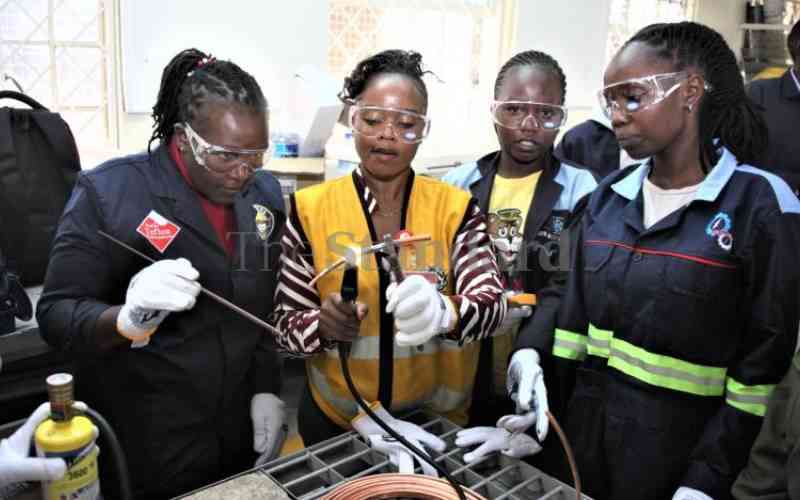
A confluence of four seemingly unrelated events in the past week provided food for thought about the future of work.
Nearly a million candidates (903,260) wrote their final Kenya Certificate of Secondary Education (KCSE) examination, and therefore crossed the Rubicon into the adult world of labour or began to actively prepare for the world of work.
Relatedly, results for the last batch of candidates to sit the Kenya Certificate of Primary Education (KCPE) examination were also released. Given the government’s 100 per cent transition to secondary school policy, nearly all the 1,406,557 are expected to take the KCSE examination in four years and subsequently join the labour force.
At about the same time, the Federation of Kenya Employers (FKE) published a survey report on the current skill needs in Kenya, which shows the areas and fields where employers have, hard-to-fill vacancies. The 521 enterprises surveyed in the study showcased a demand for skills in various career fields including information technology (28.4%), finance and business management (27.4%), engineering (19.2%), transportation, distribution, and logistics (18.6%), and legal (18.2%).
A fifth of all employers surveyed said they could not fill vacancies in their establishments because there were no skilled people to employ or could not afford the high pay expected by applicants. Where employers could not find skills for the job, they preferred to train staff, hire below qualifications, or keep the positions vacant.
Finally, the selection of candidates for the second cohort of the Propel A Dual Apprenticeship Programme was concluded. They join as the first group of 100 – 78 male and 22 female – apprentices selected last year enters its second and final year of training.
Application is open to young men and women passionate about plumbing and electrical trades, have completed secondary school, and are aged between 18 and 30. Some 20 applicants enrolled in the programme, run by Swisscontact in partnership with training institutions and private sector firms, scored Grade A in KCSE.
The 20 top examination performers are part of a growing number of youth choosing to pursue a technical and vocational training pathway over the traditional academic route to university. Statistics from the Kenya Universities and Colleges Central Placement Service (KUCCPS) show that 15,547 who had met the minimum university entry requirements in 2021 KCSE examination instead opted to enrol for a Technical, Vocational Education Training (TVET) course.
The trend was bucked up last year when the number reduced to 9,673 university qualifiers but these figures only reinforce insights from the FKE survey: more youth with a first degree are more employable if they also possess a technical skill qualification These findings and current realities signal that youth in Kenya are positioning themselves to participate in the economy in a manner that gives them dignity and value for their contribution, which is a welcome break from the dominant story of youth unemployment and despair.
Technical education has been burdened by the unfortunate history, started by the colonial practice, that sought to assign menial handiwork as the ordained occupation of mentally inferior Kenyans and by extension Africans.
This attitude has bifurcated education into a false dichotomy between practical learning and intellectual pursuit. The FKE survey puts paid to these assumptions. Not only are technical fields available for up to the highest levels of certification, such as doctoral degrees, the findings indicate that besides a first degree, the most sought-after employees are those who also have a technical skill.
Technical skills training has continued to be unfairly lumped with unskilled menial labour even as technological advancements mechanise most work and require a mixture of dexterity and versatility to use complex tools for work. The most in-demand engineering skills, according to the FKE survey, are computer and software engineering (30%), followed by electronics and electrical engineering (27%) and mechanical and production engineering (25%). These findings are a direct and frontal challenge to technical and vocational training institutions to rise to meet the need in the market.
The sharp rise in the cost of university education is increasingly persuading many students to reassess their education choices and the subsequent prospects– especially because the artificial prestige barrier between technical and academic training is crumbling.
Only last week, Technical and Vocational Education Training PS Esther Mworia announced that the Kenya Credit Accumulation and Transfer System (KCATs) – currently being rolled out by the National Qualifications Authority – would allow students in TVET institutions to advance their learning up to doctorate level.
Similarly, those who have received degree training at various levels could also gain technical skills. These developments confirm that the choice to increase technical skills in Kenya through training and creating opportunities for apprenticeship is the correct path to tackle youth unemployment and eventually spur economic growth.
Training institutions should be empowered to train more people in engineering and information technology-related areas while working together and alongside employers to bridge the skills gap in the workplace.
This is one way of signalling the capacity of education certificates in the labour sector. Additionally, the country should invest in programmes and activities that boost soft skills, positive attitudes, values and ethnics among learners while creating flexible policies that enable young people (15 -25 years) access formal workplaces to learn and grow their skillset.
-lillian.mwai@swisscontact.org